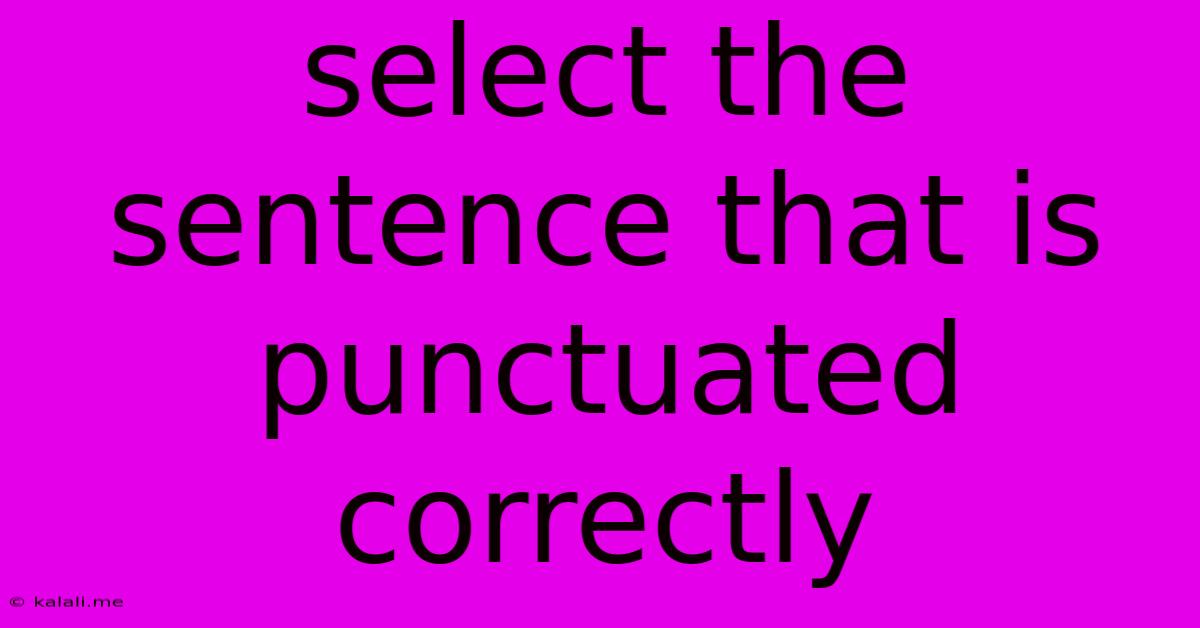Select The Sentence That Is Punctuated Correctly
Kalali
Jun 13, 2025 · 3 min read

Table of Contents
Selecting the Correctly Punctuated Sentence: A Guide to Mastering Punctuation
This article will help you understand the nuances of punctuation and choose the correctly punctuated sentence from a group of options. Mastering punctuation is crucial for clear and effective communication, both in writing and reading comprehension. It directly impacts your ability to convey your intended meaning accurately. We'll cover common punctuation errors and strategies to avoid them.
Understanding Common Punctuation Errors
Many punctuation mistakes stem from a misunderstanding of basic rules. Let's address some of the most frequent issues:
-
Comma Splices: Joining two independent clauses with only a comma. This is incorrect. You need a semicolon, a conjunction (like "and," "but," "or"), or to make them two separate sentences.
-
Misuse of Semicolons: Semicolons connect closely related independent clauses. They shouldn't be used to connect phrases or dependent clauses.
-
Incorrect Apostrophe Usage: Apostrophes indicate possession or contractions. Common errors include using them with possessive pronouns (its, hers, ours) or misplacing them in contractions.
-
Dash vs. Hyphen: Dashes indicate a break or interruption, while hyphens join words or parts of words.
-
Overuse or Underuse of Commas: Knowing when to use commas in lists, with introductory phrases, or to set off clauses is crucial for clarity.
Strategies for Identifying Correctly Punctuated Sentences
When faced with multiple sentence options, consider these steps:
-
Read each sentence carefully: Pay close attention to the flow and meaning. Does anything sound awkward or unclear?
-
Identify independent and dependent clauses: Understanding the structure of each sentence will help you determine if the punctuation accurately reflects the relationship between the clauses.
-
Check for comma splices and semicolon misuse: These are common errors that significantly impact sentence correctness.
-
Examine apostrophe usage: Ensure that apostrophes are used correctly to show possession or contractions.
-
Review dash and hyphen usage: Make sure dashes and hyphens are used appropriately according to their grammatical function.
-
Look for comma errors: Ensure commas are used effectively to separate items in lists, set off introductory phrases, and clarify the meaning of complex sentences.
-
Read the sentence aloud: Sometimes reading aloud helps you hear where the punctuation should be. Does the punctuation reflect the natural pauses and rhythm of the sentence?
Example
Let's look at an example. Which of the following sentences is correctly punctuated?
a. The dog barked loudly, the cat hissed menacingly. b. The dog barked loudly; the cat hissed menacingly. c. The dog barked loudly, and the cat hissed menacingly.
The correct answer is b and c. Sentence a is a comma splice. Sentences b and c correctly use a semicolon and a coordinating conjunction, respectively, to join the two independent clauses.
Conclusion
Mastering punctuation is essential for effective writing and reading comprehension. By understanding common punctuation errors and employing the strategies outlined above, you can confidently select the correctly punctuated sentence and improve your overall writing skills. Regular practice and attention to detail are key to achieving punctuation perfection. Remember to always proofread your work carefully before submitting it!
Latest Posts
Latest Posts
-
How Does Representative Democracy Differ From Direct Democracy
Jun 14, 2025
-
Is Dembele Right Or Left Footed
Jun 14, 2025
-
The Ends Of A Long Bone Are Known As The
Jun 14, 2025
-
Most Abundant Metal In The Earth Crust
Jun 14, 2025
-
The Area Under A Velocity Time Graph Represents
Jun 14, 2025
Related Post
Thank you for visiting our website which covers about Select The Sentence That Is Punctuated Correctly . We hope the information provided has been useful to you. Feel free to contact us if you have any questions or need further assistance. See you next time and don't miss to bookmark.